The Cambridge History of Japan, Vol. 3: Medieval Japan
Подождите немного. Документ загружается.

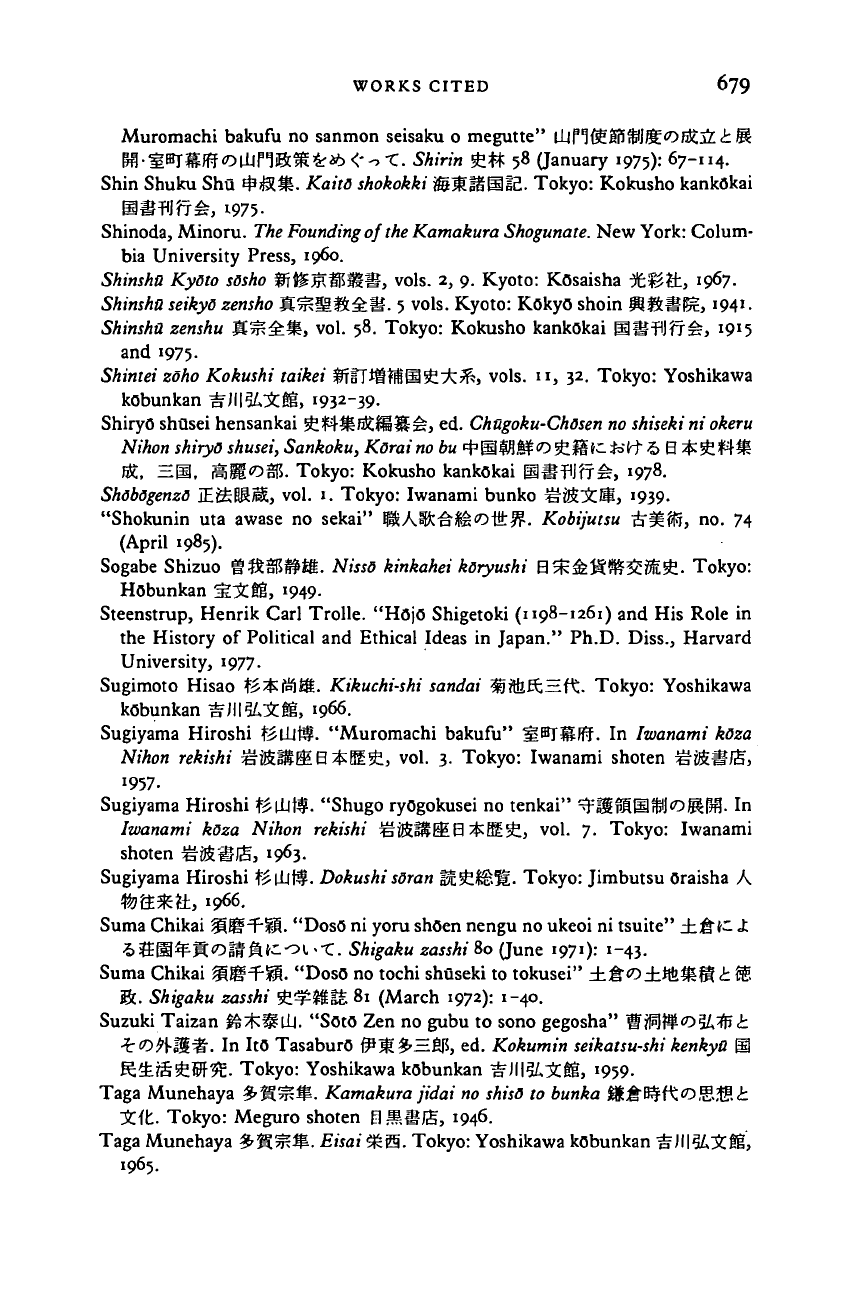
WORKS CITED 679
Muromachi bakufu no sanmon seisaku o megutte"
M-^BlSfff'OajHi&SE^* <-ot. Shirin £# 58 (January 1975): 67-114.
Shin Shuku Shu $$.%. Kaito shokokki ?SS!tSf£. Tokyo: Kokusho kankOkai
mmvmg, 1975-
Shinoda, Minoru.
The Founding
of
the
Kamakura
Shogunate.
New York: Colum-
bia University Press, i960.
Shinshtt Kyoto
sOsho
Sft^MfftSlir, vols. 2, 9. Kyoto: KOsaisha ft^tt, 1967.
Shinshtt
seikyo zertsho
K^M&ik'ii- 5 vols. Kyoto: KokyO shoin
j^SUSc,
1941.
Shinshu zenshu JK^£*, vol. 58. Tokyo: Kokusho kankOkai WHsWfi£, i
Q1
5
and 1975.
Shintei zoho Kokushi taikei $f§T*f?il!£:*:^, vols. n, 32. Tokyo: Yoshikawa
kobunkan ^Jl|&;fcgt, 1932-39.
ShiryO shusei hensankai J^iffiSl^, ed.
Chugoku-Chosen
no shiseki ni
okeru
Nihon
shiryO
shusei,
Sankoku, Koraino bu 4"BSH]B<95tiiKl*>W£
H
*S&^4^
t£.
HI, «^<Og!5. Tokyo: Kokusho kankOkai m9Wa£, 1978.
ShebOgenzO
1E&MM,
vol. 1. Tokyo: Iwanami bunko Sffi^tS, 1939.
"Shokunin uta awase no sekai" ©iA^a'^OiS^. Kobijutsu 1$W$i, no. 74
(April 1985).
Sogabe Shizuo ^^.UWi&.
NissO
kinkahei
kOryushi
BSR<!^!^. Tokyo:
Hobunkan SXffi, 1949-
Steenstrup, Henrik Carl Trolle. "HojO Shigetoki (1198-1261) and His Role in
the History of Political and Ethical Ideas in Japan." Ph.D. Diss., Harvard
University, 1977.
Sugimoto Hisao <£#(nigi. Kikuchi-shi sandai HjfeftHft. Tokyo: Yoshikawa
kobunkan ^Jll^^Cgg, 1966.
Sugiyama Hiroshi
felhW--
"Muromachi bakufu" MBlSW. In Iwanami
kOza
Nihon rekishi isti&MB.B&M.'fc, vol. 3. Tokyo: Iwanami shoten SJStf/£>
1957.
Sugiyama Hiroshi
&\liW.
"Shugo ryOgokusei no tenkai" ^HnSHtSIJ<OjR!lfl. In
Iwanami kOza Nihon rekishi i=ji!£il@* 0 ^fll'fc, vol. 7. Tokyo: Iwanami
shoten g$»/£, 1963.
Sugiyama Hiroshi #LUi#. Dokushi
sdran
^£HiK. Tokyo: Jimbutsu Oraisha A
w&m±, 1966.
Suma Chikai glll^St. "DosO ni yoru shOen nengu no ukeoi ni tsuite" ±^"t-
<t
^Sffl^PiOltAK.OI, >t. Shigaku zasshi 80 (June 1971): 1-43.
Suma Chikai 2gg-f-SI. "DosO no tochi shuseki to tokusei"
St. Shigaku zasshi
S^JffS
81 (March 1972): 1-40.
Suzuki Taizan ^^^UU. "SotO Zen no gubu to sono gegosha"
. In ItO TasaburO ^^^Hfifl, ed. Kokumin seikatsu-shi
kenkyU
S3
t Tokyo: Yoshikawa kobunkan ^Jll&^gt, 1959-
Taga Munehaya
%%"%.%.
Kamakura jidai no shisd to bunka
~$C\t.
Tokyo: Meguro shoten
El
Hfi/S, 1946.
Taga Munehaya
%>%%%.
Eisai ^S. Tokyo: Yoshikawa kobunkan
1965.
Cambridge Histories Online © Cambridge University Press, 2008
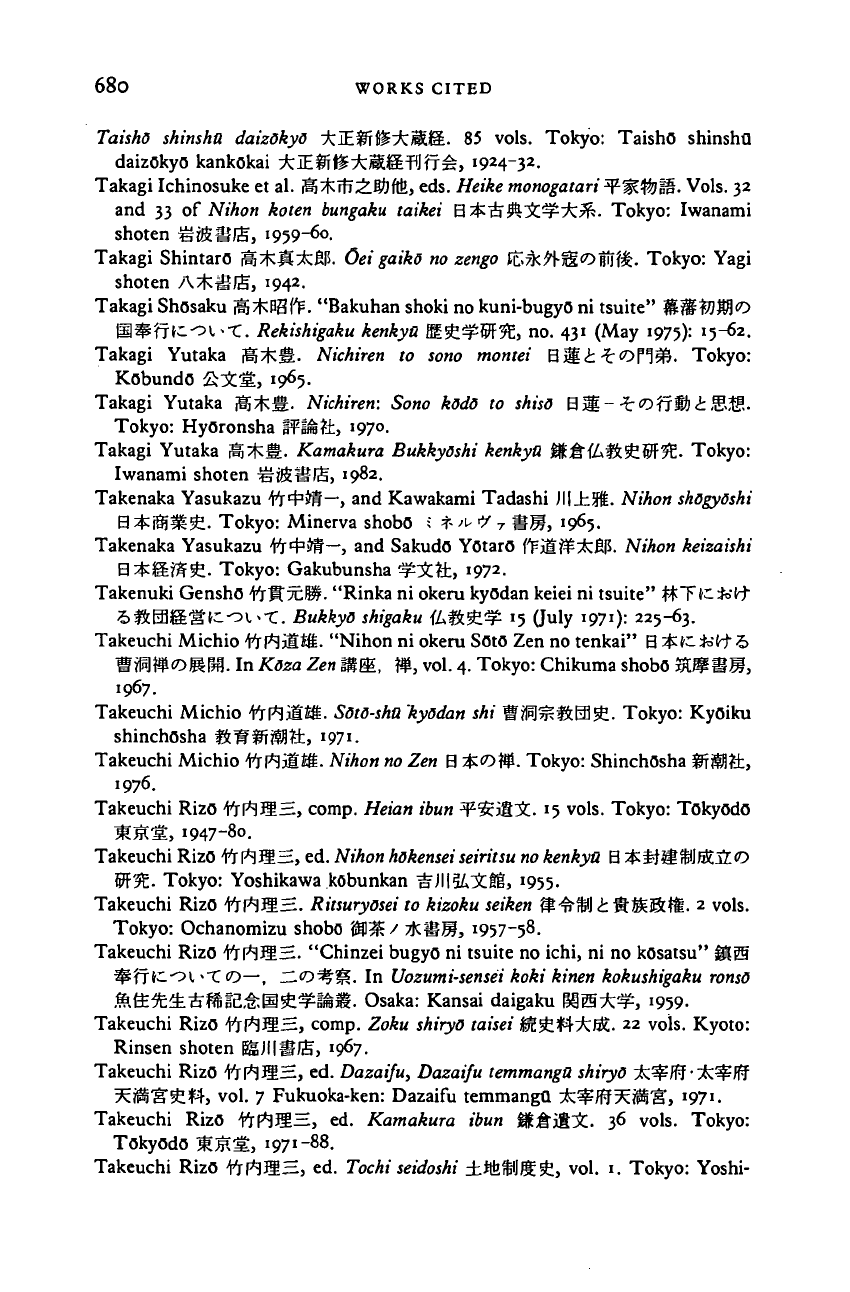
680 WORKS CITED
TaishO
shinshu daizdkyo
-k.'SM'^'kWM..
85 vols. Tokyo: TaishO shinshu
daizokyo kankokai -klE%ife±W.&.Wfig, 1924-32.
Takagi Ichinosuke et al.
M~fcrfi2.$)i&,
eds.
Heike monogatari
W-^tylfm-
Vols.
32
and 33 of Nihon koten
bungaku
taikei
Wfc'fe&'X'^-'k.lfc.
Tokyo: Iwanami
shoten SzSIJJg, 1959-60.
Takagi ShintarO jft^Jttgp.
Oei gaiko no zengo
fE^^f^OBU^. Tokyo: Yagi
shoten A^tf
l£,
1942.
Takagi Shosaku ifi^BSfP. "Bakuhan shoki no kuni-bugyO ni tsuite"
MWffifflcO
H^fTtco(.>t.
Rekishigaku kenkyQ
fS£^W3E, no.
431
(May 1975): 15-62.
Takagi Yutaka M^-A- Nichiren to sono montei BSi-^oTO. Tokyo:
KobundO S:£g, 1965.
Takagi Yutaka K^H.
Nichiren:
Sono kodo to
shisO
BM-^VfjWik&W.-
Tokyo: HyOronsha ffPUft, 1970.
Takagi Yutaka fij^H:.
Kamakura BukkyOshi kenkyQ
MMiL%k%M'$£..
Tokyo:
Iwanami shoten ^fj&IBFS, 1982.
Takenaka Yasukazu
Ys'PiM—,
and Kawakami Tadashi Jl|±3t. Nihon
shogyOshi
S *ffilil£. Tokyo: Minerva shobO ;
?-
/u •/
7
mW, J965.
Takenaka Yasukazu
fr+Jf—,
and SakudO YOtarO f'Fii^^cfip. Nihon
keizaishi
B#g??rS&. Tokyo: Gakubunsha ^;£&, 1972.
Takenuki Gensho ftf%i. "Rinka ni okeru kyOdan keiei ni tsuite" #T*
?>f!cHe#t-oi.«x. Bukkyo
shigaku
iL&.%& 15 Quly 1971): 225-63.
Takeuchi Michio firrtitit. "Nihon ni okeru
SotO
Zen no tenkai" 0
WPWoilM. In
Koza Zen
M&.,
W,
vol.
4.
Tokyo: Chikuma shobO
1967.
Takeuchi Michio firfli!t£.
Soto-shu kyOdan
shi
MW^^M^..
Tokyo: KyOiku
shinchOsha tiWffi^tt, »97>.
Takeuchi Michio ftrl*3itt£. MAon
«o
Ze« 0 #©#. Tokyo: ShinchOsha ffSfltt,
1976.
Takeuchi RizO t5rrtSS, comp. //Wan t'6«» T^JS^C. '5 vols. Tokyo: TokyOdO
laf, 1947-80.
Takeuchi
RizO
ttftJIH, ed.
N»Ao« hakensei seiritsu no kenkya H
*it^^J^ci!:<O
W5E. Tokyo: Yoshikawa kobunkan ^JII^A^tlg, 1955.
Takeuchi RizO
ft-^IS.
RitsuryOsei
to kizoku
seiken
W-§18\
fkW&W..
2 vols.
Tokyo: Ochanomizu shobo ffll^/
^Ktf^,
1957-58.
Takeuchi RizO ftfllS. "Chinzei bugyO ni tsuite no ichi, ni no kOsatsu" US
§. In
Uozumi-sensei
koki
kinen kokushigaku ronsO
i. Osaka: Kansai daigaku KS*^, i959-
Takeuchi RizO HrfllS, comp.
ZO^M
shiryo taisei
WHZ.Pt~kfli.
22 vols. Kyoto:
Rinsen shoten Egilltf/S, 1967.
Takeuchi RizO ttrtIS, ed.
Dazaifu,
Dazaifu temmangQ shiryO ;*;$/}? •
:*:¥tff
^W&St^ vol. 7 Fukuoka-ken: Dazaifu temmangO i:^/3^iffi'S^, '97'.
Takeuchi RizO ttl^IH, ed. Kamakura ibun g|#iti. 36 vols. Tokyo:
TokyOdO
3ICM£, i97»-88.
Takeuchi RizO ft^IH, ed.
Tochi seidoshi
±*fe$]K£, vol. 1. Tokyo: Yoshi-
Cambridge Histories Online © Cambridge University Press, 2008
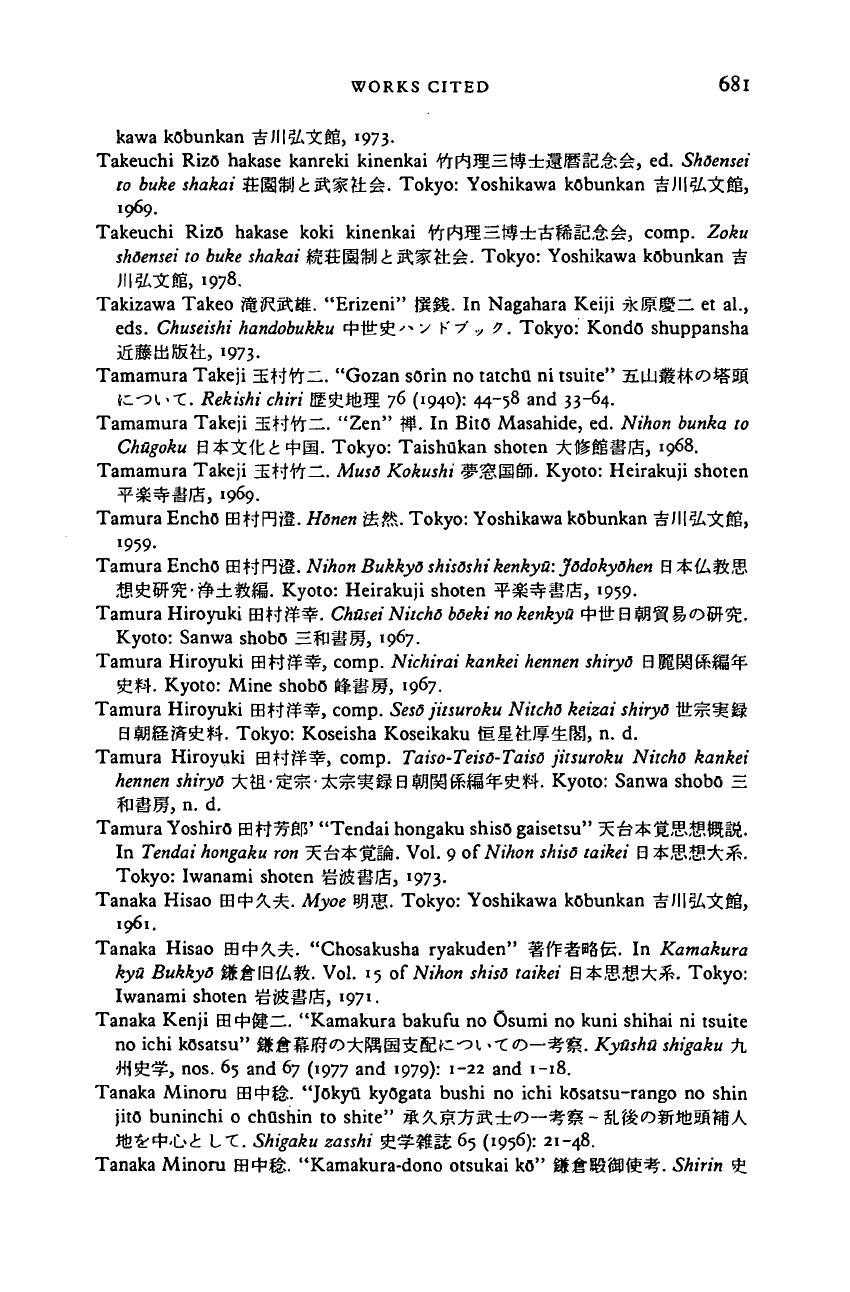
WORKS CITED 68l
kawa kobunkan ^Jll&ittt, 1973.
Takeuchi RizO hakase kanreki kinenkai Yjftm=.W±MMn£&&, ed. Shoensei
to buke shakai &[!!$)£j$g?ft£. Tokyo: Yoshikawa kobunkan ^Jll&^gl,
1969.
Takeuchi RizO hakase koki kinenkai YsfaM=.W±-&W>ii&£, comp. Zoku
shoensei
to
buke
shakai S&ISflJiS^fitis. Tokyo: Yoshikawa kobunkan ^
JllSfcfcJI, 1978.
Takizawa Takeo
feR&M.
"Erizeni" g^. In Nagahara Keiji TKiCJg— et al.,
eds.
Chuseishi handobukku
4"ifi:£'
x
~s
V~?
* 9. Tokyo: KondO shuppansha
ifi»HiliS&, 1973.
Tamamura Takeji EEftfrzi. "Gozan sOrin no tatchQ ni tsuite"
1L|JUJ|£#©*§-3R
toi 'X. Rekishi chiri Hftt&JI 76 (1940): 44-58 and 33-64.
Tamamura Takeji 3EfctttH. "Zen" ff. In BitO Masahide, ed. Nihon bunka to
ChGgoku
0 #:£{[: i^S. Tokyo: Taishtlkan shoten ±&f&9l£, 1968.
Tamamura Takeji Bttt".
MusO
Kokushi ^^,BSfi. Kyoto: Heirakuji shoten
¥*^«/S,
1969.
Tamura EnchO fflftHrl. Honen
fej&.
Tokyo: Yoshikawa kobunkan
1959-
Tamura EnchO fflttPlil. NihonBukkyOshisdshikenkyd:
Jodokydhen
S!5fcBF3E-#±til!. Kyoto: Heirakuji shoten ¥£#«/£, 1959.
Tamura Hiroyuki
fflWW¥.
ChUsei
Nitcho
bSeki
no
kenkyu
4>12:0
%&
Kyoto: Sanwa shobo HfoUJI, »9
6
7.
Tamura Hiroyuki
BBttf^,
comp. Nichirai kankei
hennen shiryO
B
£f4.
Kyoto: Mine shobo ttif W, 1967.
Tamura Hiroyuki EB+^fi^, comp.
SesO
jitsuroku Nitcho keizai
shiryO
B$8&.ffi%.n. Tokyo: Koseisha Koseikaku MM&Ji^fS, n. d.
Tamura Hiroyuki EB+tfi^, comp.
Taiso-TeisO-TaisO
jitsuroku Nitcho kankei
hennen shiryO
^ffl-^^-^^H^B^M^S^SW. Kyoto: Sanwa shobo =
fDfiS,
n. d.
Tamura YoshirO Htt^fiP' "Tendai hongaku shiso gaisetsu" 5?^
In
Tendai
hongaku ron
^"a^ jCimi. Vol. 9 of
Nihon
shisO
taikei 0
Tokyo: Iwanami shoten ^zS8lS> '973-
Tanaka Hisao ffl4>X*. Afyw BJ®. Tokyo: Yoshikawa kobunkan
1961.
Tanaka Hisao EB4>^^. "Chosakusha ryakuden" H-fF^B§<K. In Kamakura
kyu Bukkyd t&&IBf£ft Vol. 15 of Nihon
shisO
taikei 0#,g.£!*&. Tokyo:
Iwanami shoten ^si&U/E, 1971.
Tanaka Kenji S^^H. "Kamakura bakufu no Osumi no kuni shihai ni tsuite
no ichi kOsatsu"
%.&M-ffi<OizWiW$M<(Z.^
'tO-#& Kydshn
shigaku
%
'JI1£^, nos. 65 and 67 (1977 and 1979): 1-22 and 1-18.
Tanaka Minoru ffl4"H. "JokyO kyOgata bushi no ichi kosatsu-rango no shin
jitO buninchi o chushin to shite"
*XM^JC±O-#^-f§L^'Ol
f
f%IHffiA
%*+'(Ji;
LT. Shigaku zasshi £^?§1£ 65 (1956): 21-48.
Tanaka Minoru ffl4^. "Kamakura-dono otsukai ko"
m^WM^.^.
Shirin ft
Cambridge Histories Online © Cambridge University Press, 2008
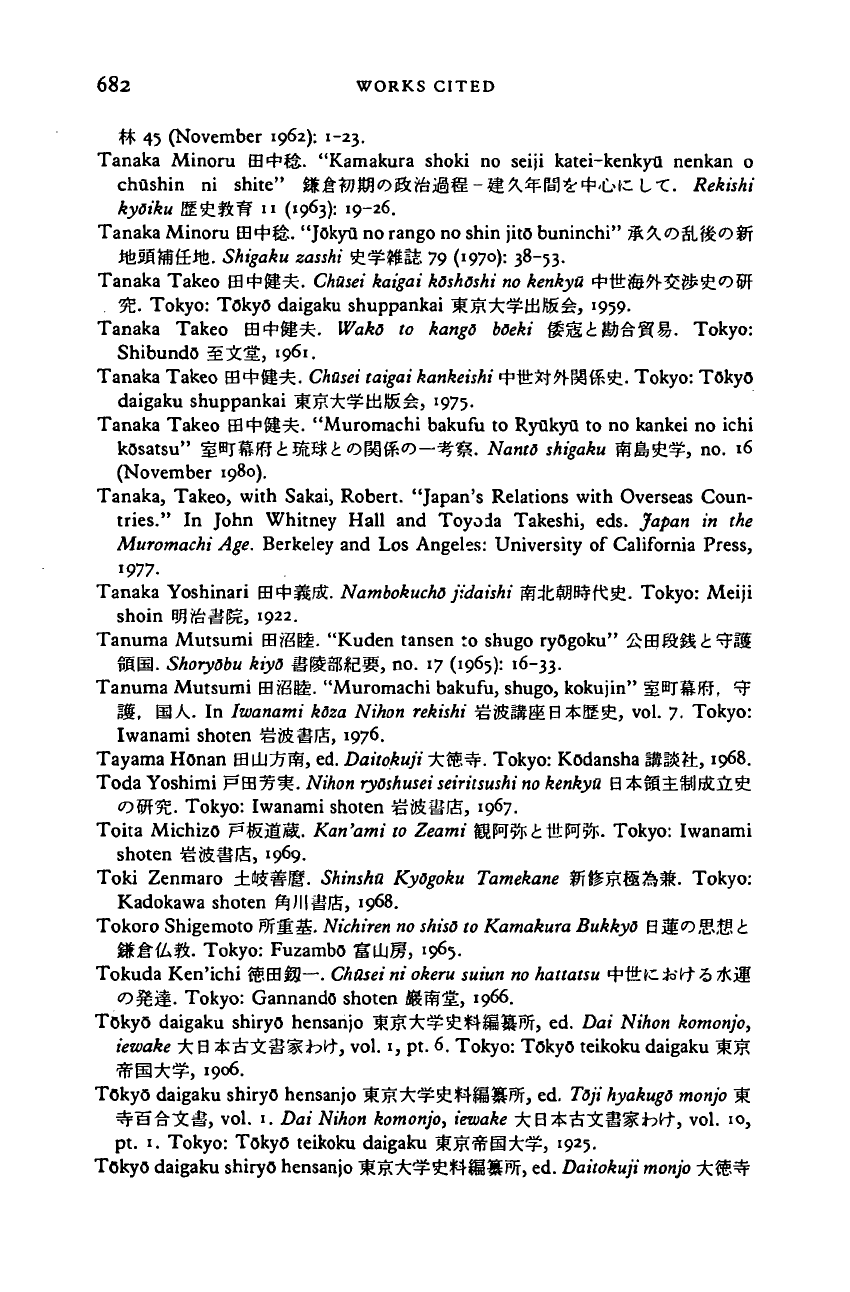
682 WORKS CITED
# 45 (November 1962): 1-23.
Tanaka Minoru BB4
1
^. "Kamakura shoki no seiji katei-kenkyfl nenkan o
chQshin ni shite" *£M8©ftte««-&^RSJ**.|JK: Lt. Rekithi
kyoiku ESSW 11 (1963): 19-26.
Tanaka Minoru EB4"?&. "Jokyu no rango no shin jito buninchi"
mmffi&m.
Shigaku zasshi
%_^mM.
79 («97o):
38-53.
Tanaka Takeo ffl4"Ct*.
Chttsei kaigai kOshdshi no kenkyU
3E.
Tokyo: Tokyo daigaku shuppankai ^M^c^tBKg^, 1959.
Tanaka Takeo ffl4>H*. Wako to kangO bdeki &1&tW)£M%i- Tokyo:
ShibundO ^JtS, 1961.
Tanaka Takeo ffl4>il^.
Chttsei taigai kankeishi
^ffirftfl-K^. Tokyo: Tokyo
daigaku shuppankai ^M^^fcBftks, >975-
Tanaka Takeo ffl+JS^. "Muromachi bakufu to Rytlkyu to no kankei no ichi
kosatsu" ^BjISJfJiSitJfcioK&O—#fl.
NantO shigaku
&$,%.-%:,
no. 16
(November 1980).
Tanaka, Takeo, with Sakai, Robert. "Japan's Relations with Overseas Coun-
tries."
In John Whitney Hall and Toyoda Takeshi, eds. Japan in the
Muromachi
Age.
Berkeley and Los Angeles: University of California Press,
1977.
Tanaka Yoshinari
ffl<fSt/j£.
NambokuchO jidaishi
&:it$8B$ft£. Tokyo: Meiji
shoin HfljfttfSt, 1922.
Tanuma Mutsumi EBrgH. "Kuden tansen to shugo ryOgoku" ^SB^C^.t^rM
mm.
Shoryobu kiyO
M&MZW,
no. 17 (1965):
16-33.
Tanuma Mutsumi EHrSHi. "Muromachi bakufu, shugo, kokujin"
gBJSfff,
**?
H, IA. In Iwanami
kOza
Nihon
rekishi
Sffi^ffiS^MS, vol. 7. Tokyo:
Iwanami shoten ^jj£i8j£, 1976.
Tayama HOnan
ffllij^^,
ed.
Daitokuji
izffl.lf.
Tokyo: Kodansha
MWtt±,
1968.
Toda Yoshimi
PB35J!)!.
Nihon ryoshusei seiritsushi no kenkytt
0 ^®EtflJfK5iSt
OP5£. Tokyo: Iwanami shoten 3si£ffij£, 1967.
Toita MichizO PSJ!^. Kan'ami to Zeami tSR3ft£i]£P°r$P. Tokyo: Iwanami
shoten §iJf(£, 1969.
Toki Zenmaro
iMMM-
Shinshu
KyOgoku Tamekane
IfUlKfij&lft. Tokyo:
Kadokawa shoten ^Jl|#?l£, 1968.
Tokoro Shigemoto
J9f1i3£.
Nichiren no shisd to Kamakura BukkyO
mMiLm. Tokyo: FuzambO
SOiW,
1965.
Tokuda Ken'ichi
ffifflla—.
Chttsei
ni
okeru suiun no hattatsu $>W
<O%M-
Tokyo: Gannando shoten S^M^, 1966.
Tokyo daigaku shiryO hensanjo ^^^^SfeiPHiSW, ed. Dai
Nihon
komonjo,
iewake
±
B
*i"ifi^^H", vol. 1, pt. 6. Tokyo: Tokyo teikoku daigaku ^M
^m-k^,
1906.
Tokyo daigaku shiryO hensanjo
^M^^^^SHHf,
ed.
Toji hyakugo monjo JK
#SpJi, vol. 1. Dai
Nihon
komonjo,
iewake
±
B
^^ittt^^H", vol. 10,
pt. 1. Tokyo: Tokyo teikoku daigaku MP^Mi:^, 1925.
Tokyo daigaku shiryO hensanjo
^M^^SifcHiHRlf,
ed.
Daitokuji monjo
Cambridge Histories Online © Cambridge University Press, 2008
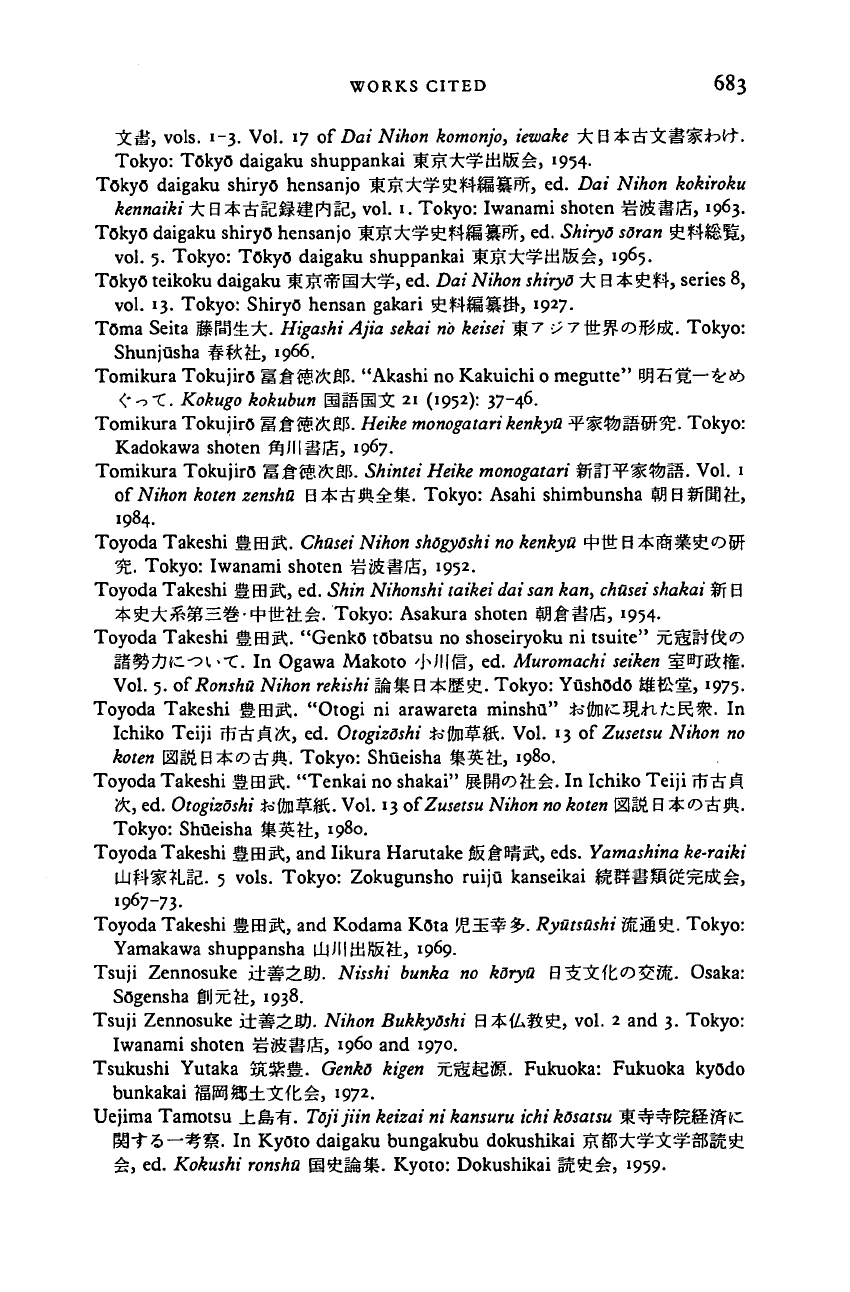
WORKS CITED 683
SUM,
vols. 1-3. Vol. 17 of Dai Nikon komonjo, iewake
Tokyo: Tokyo daigaku shuppankai Sw^^ffiltS^, *954-
Tokyo daigaku shiryo hensanjo ^M±^^^l-S®f5f, ed. Dai Nihon kokiroku
kennaiki ^B^fc^faSSIffilE, vol. 1. Tokyo: Iwanami shoten S$?1tJ£,
i9
6
3-
Tokyo daigaku shiryO hensanjo
W?,±¥'£.PtMW
i
f\,
ed.
ShiryO sOran
5&^4^R,
vol.
5. Tokyo: Tokyo daigaku shuppankai SM^^HJRS^, 1965.
Tokyo teikoku daigaku ^M^?H±^, ed. Dai Nihon
shiryO
iz
B
^
^W-,
series 8,
vol.
13. Tokyo: ShiryO hensan gakari 5fcftfll&&, 1927-
Toma Seita
W?ml!k3:.
Higashi Ajia sekai no keisei ^T i/TWRol&Jfc. Tokyo:
Shunjusha ##<&:, 1966.
Tomikura TokujirO Witf&'Affi. "Akashi no Kakuichi o megutte"
WS^—
£r#>
<-ot. Kokugo kokubun WBWX 21 (1952): 37~4
6
-
Tomikura TokujirO gj-jg&gp.
//<?;&? monogatari kenkyQ
:
fM%lB§W$L. Tokyo:
Kadokawa shoten ^JIIil/25, 1967.
Tomikura TokujirO HJr{g;^£|$. Shintei Heike monogatari frfPF^$fSi§. Vol. 1
of Nihon koten zensha
B*^"^^:^.
Tokyo: Asahi shimbunsha
1984.
Toyoda Takeshi gfflit ChttseiNihon
shOgydshi
no kenkyu
^£.
Tokyo: Iwanami shoten
i
e&WiJ£, 1952.
Toyoda Takeshi HffiiS;, ed. SAm Nihonshi taikei dai
san
kan,
chasei
skakai ff
B
#£;*:*if?H#-*!«:&£. Tokyo: Asakura shoten
^ttt/S,
1954-
Toyoda Takeshi HfflK. "GenkO tobatsu no shoseiryoku ni tsuite" 7
Wk^t]^^^ >t\ In Ogawa Makoto
'JWIIff,
ed. Muromachi seiken
Vol. 5. of Ronshu Nihon rekishi m%
B
*E£. Tokyo: YushOdO «t&^, 1975-
Toyoda Takeshi ftBBs'i. "Otogi ni arawareta minshQ"
5s<dNitZ.J&t\tzB:%t.
In
Ichiko Teiji
Tfi-&g.'fc,
ed.
OtogizOshi
*jft]^ffi. Vol. 13 of Zusetsu Nihon no
koten |2ltftB#<D#&. Tokyo: Shueisha ^^9:, 1980.
Toyoda Takeshi ^fflSt "Tenkai no shakai"
S^Oft^.
In Ichiko Teiji
^, ed.
OtogizOshi
*>flm^8£. Vol. 13 of Zusetsu Nihon no koten
Tokyo: ShQeisha *3?tt, 1980.
Toyoda Takeshi gfflft, and Iikura Harutake ISi^BSK, eds. Yamashina ke-raiki
Lljf4S<*LI£. 5 vols. Tokyo: Zokugunsho ruiju kanseikai ffi.%$tW(£7Ef&.£,
1967-73-
Toyoda Takeshi gfflSt, and Kodama Kota ^5^£. Ryutsdshi jJffiiBSt. Tokyo:
Yamakawa shuppansha UJillfctifiSfl:, 1969.
Tsuji Zennosuke i±#;£.#J. Nisshi bunka no
kOryQ
B^.~Xit<O^0S.. Osaka:
Sogensha fllxtt, 1938.
Tsuji Zennosuke i±W2.8). Nihon BukkyOshi
B%{LW(.%.,
vol. 2 and 3. Tokyo:
Iwanami shoten sZ&tr/£,
J
96o and 1970.
Tsukushi Yutaka ja$?li. Gen/fe5 /Sti^eM x^SK. Fukuoka: Fukuoka kyOdo
bunkakai ^P3^±X<k^, 1972.
Uejima Tamotsu
±ft^f.
Tdjijiin keizai ni kansuru
ichi
kdsatsu
[Hi"5—
#^. In Kyoto daigaku bungakubu dokushikai
£, ed. Kokushi ronshu BSI«^. Kyoto: Dokushikai Sc£#, 1959-
Cambridge Histories Online © Cambridge University Press, 2008
¶
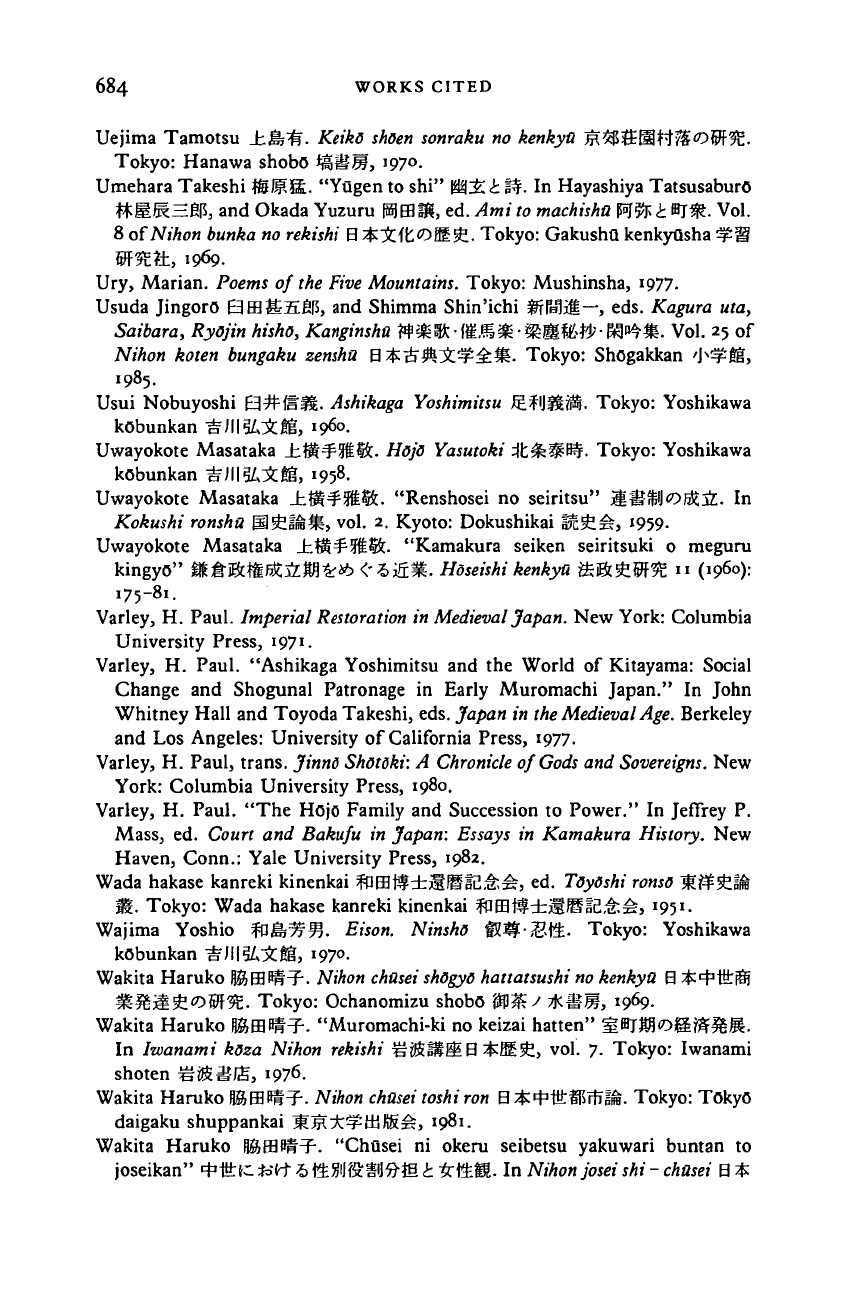
684 WORKS CITED
Uejima Tamotsu ±J&^. KeikO shoen sonraku no kenkya
Tokyo: Hanawa shobo
*iiiiilW,
>97°-
Umehara Takeshi MWM- "Yagen to shi" M± 11$. In Hayashiya TatsusaburO
ttltflHEP, and Okada Yuzuru WfflsR, ed. Ami to machisha R3ft£BT*. Vol.
8 of Nihon bunka no rekishi
B
'fc~$l'it
cr
>M$l.
Tokyo: GakushQ kenkyusha 3&||
W5Ett, 1969.
Ury, Marian. Poems of the Five Mountains. Tokyo: Mushinsha, 1977.
Usuda JingorO E3BBttEg(5, and Shimma Shin'ichi ffFifljii--, eds. Kagura uta,
Saibara, RyOjin hisho, Kanginshu ftjg|fc-fIJB;g-^f&fcJ'--&^*. Vol. 25 of
Nihon koten bungaku zensha B*^AiC^^:*. Tokyo: ShOgakkan 'h^tg,
1985.
Usui Nobuyoshi E3#faS8. Ashikaga Yoshimitsu
%.%\\%*M.
Tokyo: Yoshikawa
kobunkan
^IW^L'ZM,
i960.
Uwayokote Masataka ii^^SI®:. Hop Yasutoki
it^M^-
Tokyo: Yoshikawa
kobunkan £JII3kfc«&, »958-
Uwayokote Masataka ±g|#3i§fc. "Renshosei no seiritsu"
MV$\<r>Wi.iL.
In
Kokushi ronshu
S^wft,
vol. 2. Kyoto: Dokushikai SCS&K, 1959.
Uwayokote Masataka _h$t#-!Jt@c. "Kamakura seiken seiritsuki o meguru
kingyO" ^#Bttt)SS:W^i6 <'*i£*. Hdseishi kenkyu ffijgc£W5£ n (i960):
175-81.
Varley, H. Paul. Imperial
Restoration
in Medieval Japan. New York: Columbia
University Press, 1971.
Varley, H. Paul. "Ashikaga Yoshimitsu and the World of Kitayama: Social
Change and Shogunal Patronage in Early Muromachi Japan." In John
Whitney Hall and Toyoda Takeshi, eds. Japan in
the
Medieval
Age.
Berkeley
and Los Angeles: University of California Press, 1977.
Varley, H. Paul, trans. Jinnd Shotoki: A
Chronicle
of
Gods
and
Sovereigns.
New
York: Columbia University Press, 1980.
Varley, H. Paul. "The HojO Family and Succession to Power." In Jeffrey P.
Mass,
ed. Court and Bakufu in Japan: Essays in Kamakura History. New
Haven, Conn.: Yale University Press, 1982.
Wada hakase kanreki kinenkai Wfflif ±MMM&£, ed.
ToyOshi ronsO
^$£fi
%£.
Tokyo: Wada hakase kanreki kinenkai %imi$±MMtZ&£, >95i-
Wajima Yoshio fpg?7?^. Eison. NinshO SWtt-igtt. Tokyo: Yoshikawa
kobunkan ^Jll&jiCfii, 1970.
Wakita Haruko HSfflW^p. Nihon
chusei shdgyo
hattatsushi no kenkya
H^^S^W^E. Tokyo: Ochanomizu shobo ffl&/ ##)>§, 1969.
Wakita Haruko
B&BBBf^.
"Muromachi-ki no keizai hatten"
In Iwanami koza Nihon rekishi ^si&M&B&B£%., vol. 7. Tokyo: Iwanami
shoten ^j£tfj£, 1976.
Wakita Haruko g&fflflfi
1
. Nihon
chasei
toshi
ron B
*
t
t
3
ffi?I>T?Tl». Tokyo: Tokyo
daigaku shuppankai ^M^C^ttifiS^, 1981.
Wakita Haruko
HSfflffS^f-.
"Chusei ni okeru seibetsu yakuwari buntan to
joseikan" •fifttcioH-SttSiJSill^fii ^rtiffi. In Nihon
josei
shi -
chasei
B*
Cambridge Histories Online © Cambridge University Press, 2008
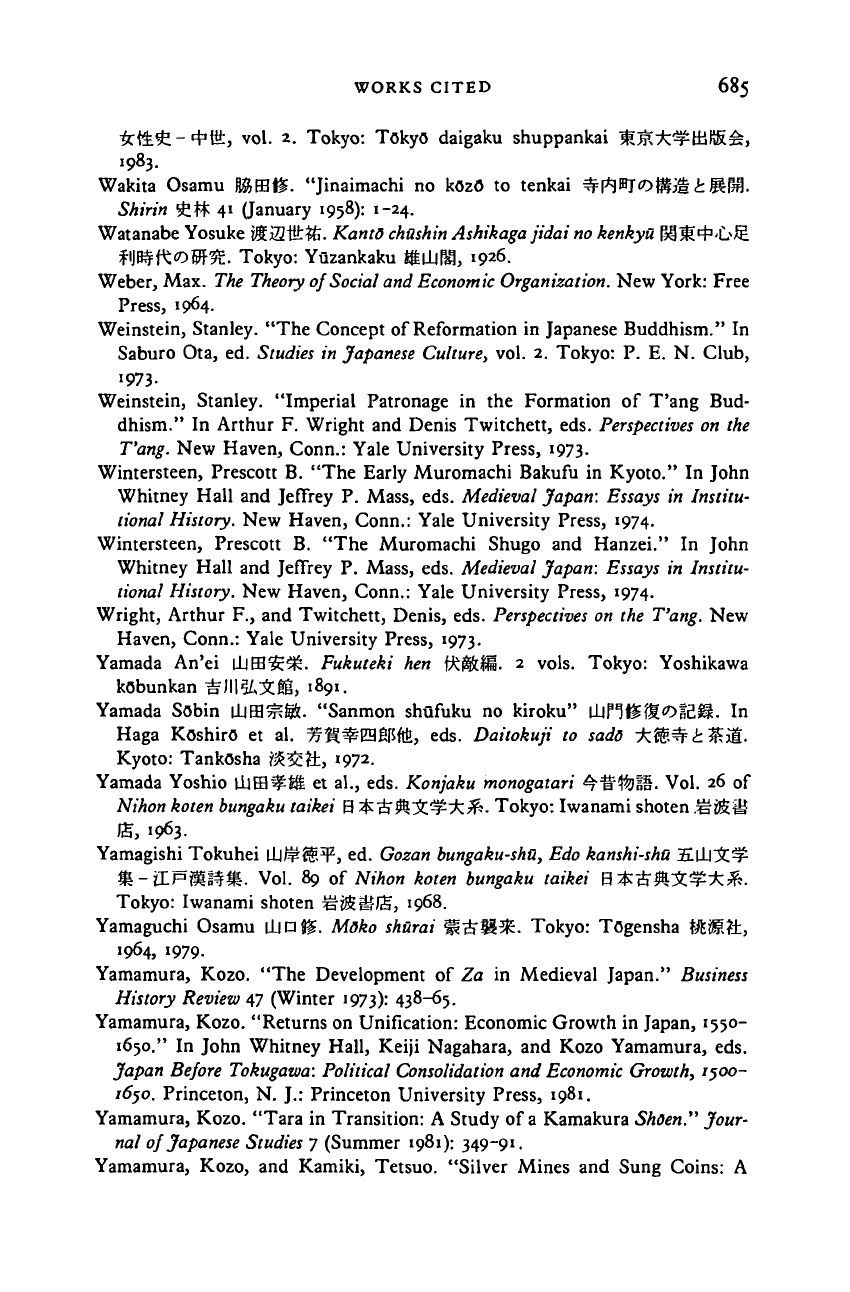
WORKS CITED 685
vol.
2. Tokyo: Tokyo daigaku shuppankai
1983.
Wakita Osamu g8ffl&. "Jinaimachi no kOzO to tenkai
Shirin £tt 41 (January 1958): 1-24.
Watanabe Yosuke WiUWfa. KantS
chashin
Ashikaga jidai
no
kenkyu
*iJB#ft<Offl?L. Tokyo: Yuzankaku *£|lj|H, 1926.
Weber, Max. The
Theory
of Social and
Economic
Organization. New York: Free
Press,
1964-
Weinstein, Stanley. "The Concept of Reformation in Japanese Buddhism." In
Saburo Ota, ed. Studies in Japanese Culture, vol. 2. Tokyo: P. E. N. Club,
1973-
Weinstein, Stanley. "Imperial Patronage in the Formation of T'ang Bud-
dhism." In Arthur F. Wright and Denis Twitchett, eds.
Perspectives
on the
T'ang.
New Haven, Conn.: Yale University Press, 1973.
Wintersteen, Prescott B. "The Early Muromachi Bakufu in Kyoto." In John
Whitney Hall and Jeffrey P. Mass, eds. Medieval Japan: Essays in Institu-
tional History. New Haven, Conn.: Yale University Press, 1974.
Wintersteen, Prescott B. "The Muromachi Shugo and Hanzei." In John
Whitney Hall and Jeffrey P. Mass, eds. Medieval Japan: Essays in Institu-
tional History. New Haven, Conn.: Yale University Press, 1974.
Wright, Arthur F., and Twitchett, Denis, eds.
Perspectives
on the
T'ang.
New
Haven, Conn.: Yale University Press, 1973.
Yamada An'ei lilffl^*. Fukuteki hen tt&®. 2 vols. Tokyo: Yoshikawa
kobunkan ^Jll&jttl, 1891.
Yamada Sobin UUffl9n®. "Sanmon shufuku no kiroku" lb?Wi%.<Ot£&- In
Haga KOshirO et al. ^S^E3fi|5ffi, eds. Daitokuji to sado :£ Jg# £ 3Sit.
Kyoto: Tankosha $>£tt, 1972.
Yamada Yoshio liiH3##£ et al., eds. Konjaku monogatari ^H^fl. Vol. 26 of
Nihon koten
bungaku
taikei 0 :££$&-%*£.-£%• Tokyo: Iwanami
/£,
1963-
Yamagishi Tokuhei uU^fg^p, ed. Gozan bungaku-shu, Edo kanshi-shu
»-tEPfiIf#. Vol. 89 of Nihon koten bungaku taikei
Tokyo: Iwanami shoten SiSif/E, 1968.
Yamaguchi Osamu UUPU. Moko shurai <ii't?3}5. Tokyo: TOgensha
1964,
1979.
Yamamura, Kozo. "The Development of Za in Medieval Japan." Business
History Review 47 (Winter 1973): 438-65.
Yamamura, Kozo. "Returns on Unification: Economic Growth in Japan, 1550-
1650."
In John Whitney Hall, Keiji Nagahara, and Kozo Yamamura, eds.
Japan Before Tokugawa: Political
Consolidation
and
Economic
Growth, 1500-
1650. Princeton, N. J.: Princeton University Press, 1981.
Yamamura, Kozo. "Tara in Transition: A Study of
a
Kamakura
ShOen."
Jour-
nal of
Japanese
Studies 7 (Summer 1981):
349-91.
Yamamura, Kozo, and Kamiki, Tetsuo. "Silver Mines and Sung Coins: A
Cambridge Histories Online © Cambridge University Press, 2008

686 WORKS CITED
Monetary History of Medieval and Modern Japan in International Perspec-
tive."
In J. F. Richards, ed.
Precious
Metals in the Later Medieval and Early
Modern Worlds. Durham, N. C: Carolina Academic Press, 1983.
Yampolsky, Philip. The Platform Sutra of
the
Sixth Patriarch. New York: Co-
lumbia University Press, 1967.
Yanagida Seizan WfflSOi. Rinzai no kafu Ks?£o|?&. Tokyo: Chikuma shobO
SCWiBW, 1967.
Yanagita Kunio UPfflBlf}. "Miko ko" Mic^. In Teihon Yanagita Kunio shu 3?
*WPBBS^*,
vol. 9. Tokyo: Chikuma shobO mSttS, 1982.
Yashiro Kuniharu AftiH^, ed. Kokushi
sOsetsu
g£i!i£. Tokyo: Yoshikawa
kobunkan ^/ll&:£!t,
i9
2
5-
Yasuda Motohisa $ffl7cX. Nihon zenshi B#ife£ {chttsei 1). Tokyo: Tokyo
daigaku shuppankai SC^^fctDSs, 1958.
Yasuda Motohisa ^BBxX.
JitO
oyobijitd
ryOshusei no kenkyO
J&aSS.O-'JfeaBffli.
$J<OW3E. Tokyo: Yamakawa shuppansha UU-IIIt±5RS?±, 1961.
Yasuda Motohisa ^fflxA. Shugo
to
jito
<%Wti$M.
Tokyo: Shibundo Mi^,
1964.
Yasuda Motohisa <i£:EH7cA. "Gokenin-sei seiritsu ni kansuru ichi shiron" M%
—
W&m.
Gakushuin daigaku
bungakubu
kenkyu nempo ^l/l^
16 (1969): 81-110.
Yasui Kodo £#l£g. HOnen monka no kySgaku ft£$|"1To£fc^. Kyoto:
HOzOkan mmm, 1968.
Yokoyama Hideya #tlll5f at Zen no Kenchiku
W<D&%&.
Tokyo: ShOkokusha ^
Yokoyama Shigeru fillilfi, and Matsumoto Rytishin t&^l^fS, eds. Muromachi
jidai monogatari taisei !l>EXB#ft!tMia^)$;, vol. 3. Tokyo: Kadokawa shoten £j
Jll«/S,
1975-
Yokozeki RyOin SiBITML. Edo jidai tOmon seiyd tL/
5
B$ft?[6lHj&^. Tokyo:
BukkyOsha fAtitt, 1950.
Yonehara Masayoshi
i^.W.'S.^..
Sengoku bushi to bungeino kenkyu R
^<OW5£. Tokyo: Ofusha fe'att, 1976.
Yoshida Tsunenaga "^fflgft. "Kitsuzokki" ^fitlB. In Sasagawa Taneo
615,
comp. ShiryO taisei. Tokyo: Naigai shoseki |*|?i-U$§, 1937.
Yoshie Akio fttH^^o "Kokuga shihai no tenkai" @gi5SE<Olgffi. In Iwanami
kOza Nihon rekishi ^sJ&M&B^M^S., vol. 4. Tokyo: Iwanami shoten ©#?|}
fS, 1976.
Zoho shiryd taisei ifM^^^r/S;, vol. 23. Kyoto: Rinsen shoten $£JII||J£, 1975.
ZoAu Gunsho ruiju
Wz&-MW&.,
33 vols. Tokyo: Zoku gunsho ruija kanseikai $c
mMmfetzmis, 1931-33-
Zuikei ShQhO Sgi^M. Zcnnw kokuhoki #PB^te. Tokyo: Kokusho kankokai
(a*f«'n^, «975-
Zusetsu Nihon no koten
|2IsJ£ S
;£<O&^. 20 vols. Tokyo: ShOseisha H)$?±, 1978-
81.
Cambridge Histories Online © Cambridge University Press, 2008
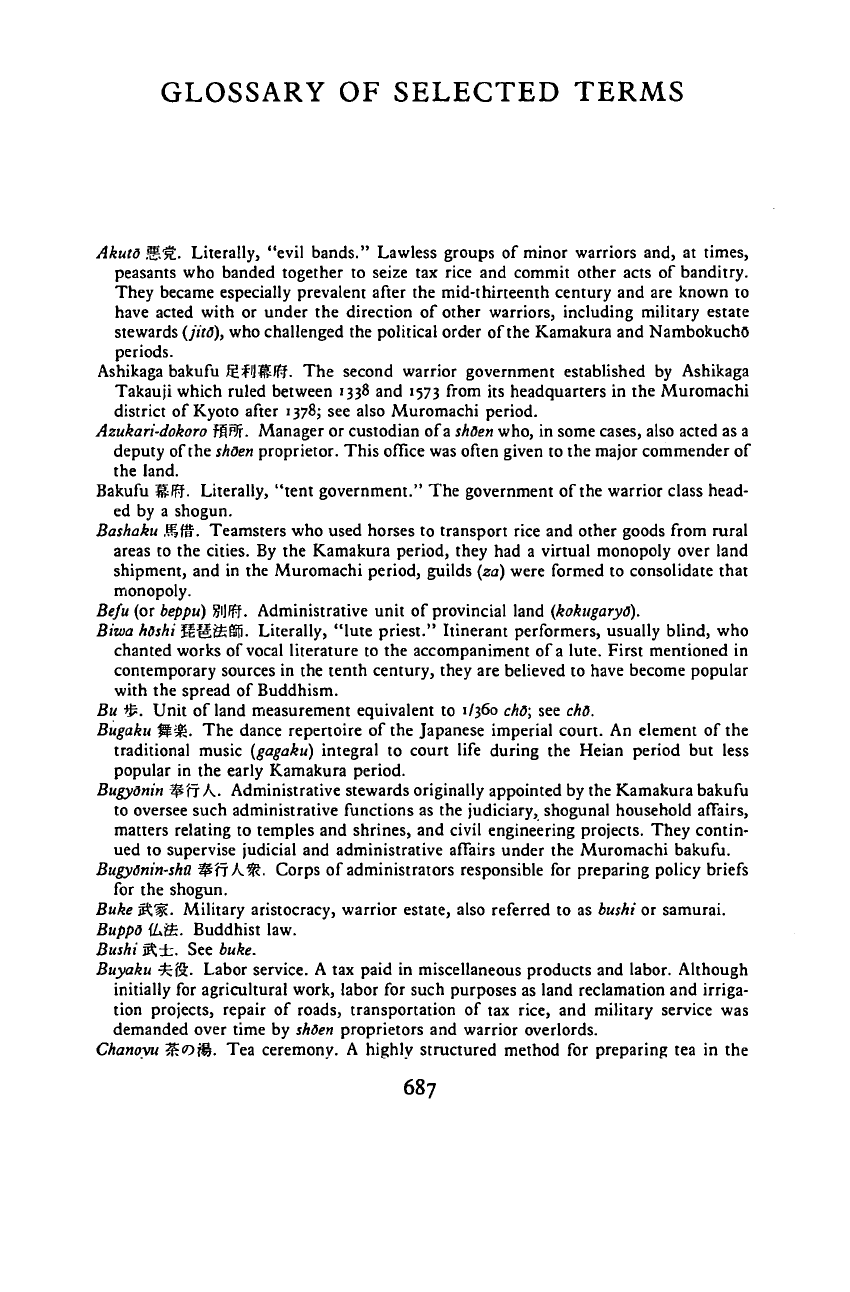
GLOSSARY
OF
SELECTED TERMS
Akuto
SIE.
Literally, "evil bands." Lawless groups
of
minor warriors
and, at
times,
peasants
who
banded together
to
seize
tax
rice
and
commit other acts
of
banditry.
They became especially prevalent after
the
mid-thirteenth century
and are
known
to
have acted with
or
under
the
direction
of
other warriors, including military estate
stewards
(jits),
who
challenged
the
political order of the Kamakura
and
NambokuchO
periods.
Ashikaga bakufu
ffifijfl^lff. The
second warrior government established
by
Ashikaga
Takauji which ruled between
1338 and
1573 from
its
headquarters
in the
Muromachi
district
of
Kyoto after
1378; see
also Muromachi period.
Azukari-dokoro
fjjfilf.
Manager
or
custodian of a
shOen
who,
in
some cases, also acted
as a
deputy
of
the
shOen
proprietor. This office
was
often given
to the
major commender
of
the land.
Bakufu
Miff-
Literally, "tent government."
The
government
of
the warrior class head-
ed
by a
shogun.
Bashaku
,BKB
.
Teamsters
who
used horses
to
transport rice
and
other goods from rural
areas
to the
cities.
By the
Kamakura period, they
had a
virtual monopoly over land
shipment,
and in the
Muromachi period, guilds
(za)
were formed
to
consolidate that
monopoly.
Befu
(or
beppu)
Si](ff.
Administrative unit
of
provincial land (kokugaryo).
Bivia
hCshi
Jlf^&Sfi- Literally, "lute priest." Itinerant performers, usually blind,
who
chanted works
of
vocal literature
to the
accompaniment
of
a lute. First mentioned
in
contemporary sources
in the
tenth century, they
are
believed
to
have become popular
with
the
spread
of
Buddhism.
Bu
$.
Unit
of
land measurement equivalent
to 1/360
chO;
see cho.
Bugaku
W<&.
The
dance repertoire
of the
Japanese imperial court.
An
element
of the
traditional music (gagaku) integral
to
court life during
the
Heian period
but
less
popular
in the
early Kamakura period.
BugyOnin
^fr
A. Administrative stewards originally appointed
by the
Kamakura bakufu
to oversee such administrative functions
as the
judiciary, shogunal household affairs,
matters relating
to
temples
and
shrines,
and
civil engineering projects. They contin-
ued
to
supervise judicial
and
administrative affairs under
the
Muromachi bakufu.
BugyOnin-sha
^'fs
K%- Corps
of
administrators responsible
for
preparing policy briefs
for
the
shogun.
Buke
f£M-
Military aristocracy, warrior estate, also referred
to as
bushi
or
samurai.
Buppo
{Lfe.
Buddhist
law.
Bushi
S^±. See
buke.
Buyaku
-£g.
Labor service.
A tax
paid
in
miscellaneous products
and
labor. Although
initially
for
agricultural work, labor
for
such purposes
as
land reclamation
and
irriga-
tion projects, repair
of
roads, transportation
of tax
rice,
and
military service
was
demanded over time
by
shOen
proprietors
and
warrior overlords.
Chanoyu
%i<Di&.
Tea
ceremony.
A
highly structured method
for
preparing
tea in the
687
Cambridge Histories Online © Cambridge University Press, 2008
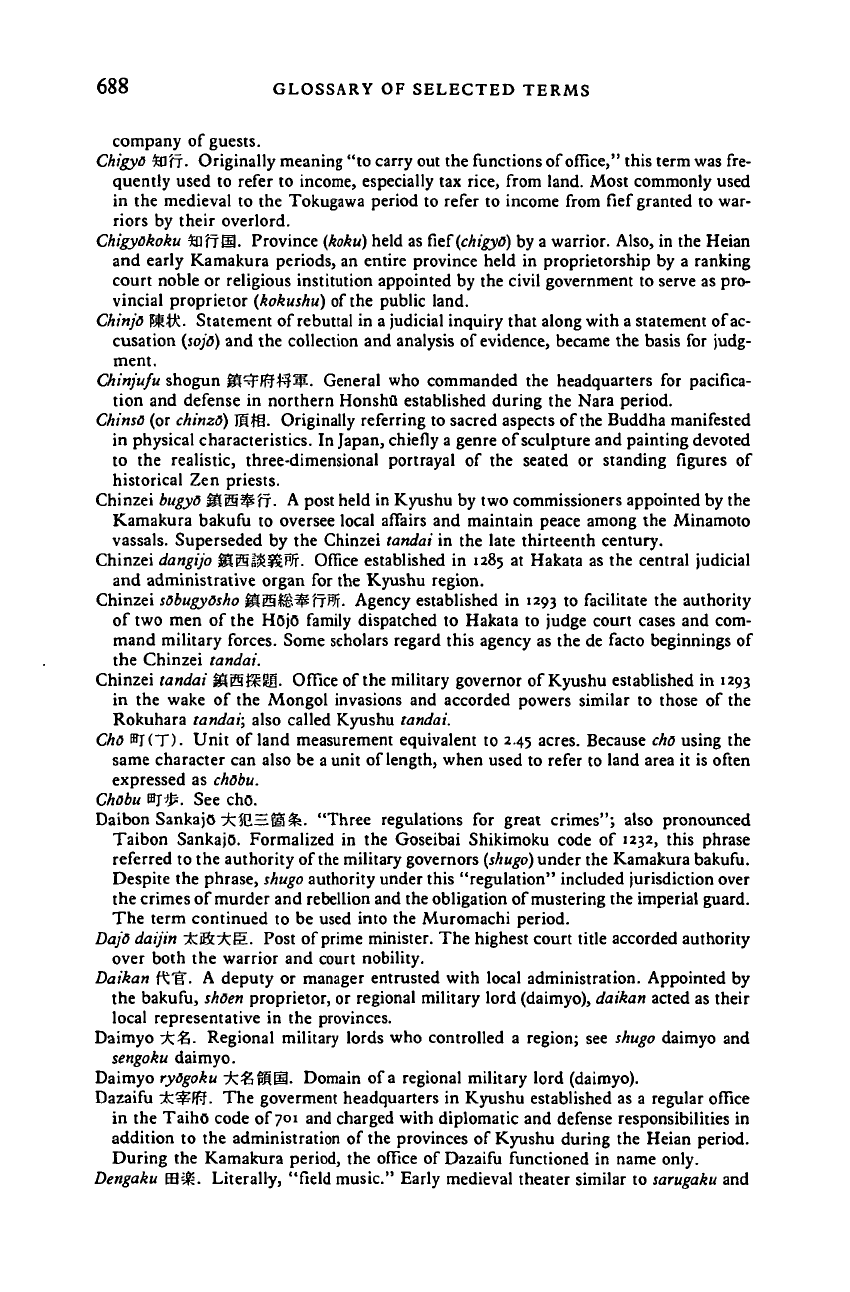
688 GLOSSARY OF SELECTED TERMS
company of guests.
Chigyo
%}'fr.
Originally meaning "to carry out the functions of office," this term was fre-
quently used to refer to income, especially tax rice, from land. Most commonly used
in the medieval to the Tokugawa period to refer to income from fief granted to war-
riors by their overlord.
ChigyOkoku
ia'nS. Province (koku) held as fief
(chigyO)
by a warrior. Also, in the Heian
and early Kamakura periods, an entire province held in proprietorship by a ranking
court noble or religious institution appointed by the civil government to serve as pro-
vincial proprietor (kokushu) of the public land.
Chinjo E^tfc. Statement of rebuttal in a judicial inquiry that along with a statement of
ac-
cusation
(sojo)
and the collection and analysis of evidence, became the basis for judg-
ment.
Chinjufu shogun
M^FI^^W-
General who commanded the headquarters for pacifica-
tion and defense in northern Honshu established during the Nara period.
ChinsO
(or chinzd) Hft!. Originally referring to sacred aspects of the Buddha manifested
in physical characteristics. In Japan, chiefly a genre of sculpture and painting devoted
to the realistic, three-dimensional portrayal of the seated or standing figures of
historical Zen priests.
Chinzei
bugyO
IfifS^fr. A post held in Kyushu by two commissioners appointed by the
Kamakura bakufu to oversee local affairs and maintain peace among the Minamoto
vassals. Superseded by the Chinzei tandai in the late thirteenth century.
Chinzei dangijo |RjSI&S£iW. Office established in 128; at Hakata as the central judicial
and administrative organ for the Kyushu region.
Chinzei
sdbugyOsho
JRSfij^fTtW. Agency established in 1293 to facilitate the authority
of two men of the HojO family dispatched to Hakata to judge court cases and com-
mand military forces. Some scholars regard this agency as the de facto beginnings of
the Chinzei tandai.
Chinzei tandai 8SS££!S. Office of the military governor of Kyushu established in 1293
in the wake of the Mongol invasions and accorded powers similar to those of the
Rokuhara tandai; also called Kyushu tandai.
Cho fff(T). Unit of land measurement equivalent to 2.45 acres. Because cho using the
same character can also be a unit of length, when used to refer to land area it is often
expressed as chobu.
ChObu
Bj*. See cho.
Daibon SankajO ^:}GH©^. "Three regulations for great crimes"; also pronounced
Taibon SankajO. Formalized in the Goseibai Shikimoku code of 1232, this phrase
referred to the authority of the military governors
(shugo)
under the Kamakura bakufu.
Despite the phrase,
shugo
authority under this "regulation" included jurisdiction over
the crimes of murder and rebellion and the obligation of mustering the imperial guard.
The term continued to be used into the Muromachi period.
Dajo daijin ±jgt^:E. Post of prime minister. The highest court title accorded authority
over both the warrior and court nobility.
Daikan ftlir. A deputy or manager entrusted with local administration. Appointed by
the bakufu, shoen proprietor, or regional military lord (daimyo), daikan acted as their
local representative in the provinces.
Daimyo
~k.%>-
Regional military lords who controlled a region; see shugo daimyo and
sengoku daimyo.
Daimyo
ryOgoku
-k&v&M-
Domain of
a
regional military lord (daimyo).
Dazaifu ii^ffi. The goverment headquarters in Kyushu established as a regular office
in the Taiho code of 701 and charged with diplomatic and defense responsibilities in
addition to the administration of the provinces of Kyushu during the Heian period.
During the Kamakura period, the office of Dazaifu functioned in name only.
Dengaku EH=£. Literally, "field music." Early medieval theater similar to sarugaku and
Cambridge Histories Online © Cambridge University Press, 2008
